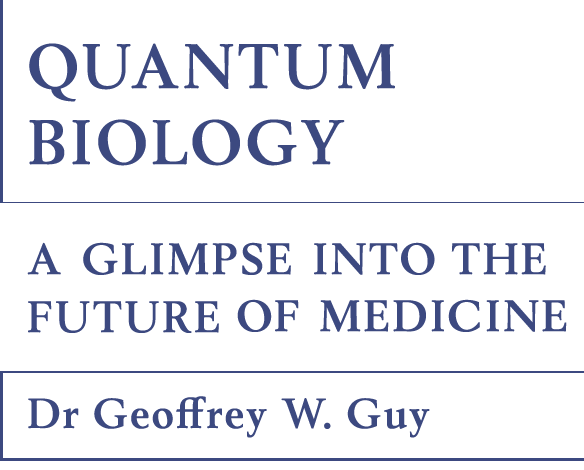
- About Geoffrey Guy
- List of chapters
- 1 Flatworms and xenobots
- 2 Beyond neurons: quantum effects in the brain
- 3 The ghost in the machine
- 4 Inflammation and equilibrium
- 5 The light fantastic
- 6 Lessons from the pandemic
- 7 Reassessing the causes of cancer
- 8 Energy, information and light
- 9 Before the origins of life
- 10 Unravelling the double helix
- 11 The computer in our cells
- 12 Space: the quantum frontier?
- 13 The quantum fractal
- 14 The path to mainstream
- Glossary
- Buy the book



11
The computer in our cells
This page provides online resources relating to Chapter 1 of Quantum Biology: A Glimpse into the Future of Medicine. Read a chapter extract, or scroll down to access figures and terminology, additional resources published by The Guy Foundation, and a list of further reading.
Name of the Chapter
Subheading
We already have the capacity inside us to store and process a volume of calculations way in excess of the most advanced modern computers, and for a fraction of the cost in terms of energy. Our bodies harness that ability because over time we have learned that there are cells that are able to recognise and remember that they came from a particular type of organism with a particular structure and function, and they are able to make a whole one again.
So, if the most powerful computers we will ever need are already inside us, how can we harness them? What will the interface look like? Will we look at the results on a screen or on our little fingers? I think the humans of the future will probably still have some parts inside them which have been manufactured by humans or by machines. But they may also have manufactured some parts for themselves. If we can regenerate an organ which has vast computing power, then in some animals we could just regenerate that. Their pineal gland might become their in-house computer.
Buy the book here
P. polycephalum is a sticky yellow mould that lives on decaying leaves and logs. Initially, it exists as a single-celled organism. But each cell can merge with others to form a supercell as much as a metre in length.
Not only can slime mould seek out food such as fungal spores, but in laboratory settings it has successfully escaped from a trap and found its way around a maze.
Cells will move towards chemicals which they find attractive, glucose for example, and away from toxins. When they move towards attractant chemicals or away from repellents, the process is known as chemotaxis. Virtually every organism that is capable of movement exhibits some type of chemotaxis.
Videos

The Guy Foundation 2021 Spring Series
Amoeba-based combinatorial optimization problem solver as a potential platform for quantum-bio computing
Professor Masashi Aono, Keio University
Masashi Aono, ‘Amoeba-inspired combinatorial optimization machines’, Japanese Journal of Applied Physics 59:6 (2020), doi.org/10.35848/1347-4065/ab8e05
Davide Cappon, Marjan Jahanshahi and Patrizia Bisiacchi, ‘Value and efficacy of transcranial direct current stimulation in the cognitive rehabilitation: a critical review since 2000’, Frontiers in Neuroscience 10 (2016), doi.org/10.3389/fnins.2016.00157
Christof Koch and Klaus Hepp, ‘The relation between quantum mechanics and higher brain functions: lessons from quantum computation and neurobiology’ (2007), theswartzfoundation.org/papers/caltech/koch-hepp-07-final.pdf
Jie Pan, ‘Characterizing true quantum computing power’, Nature Computational Science 1:15 (2021), doi.org/10.1038/s43588-020-00018-3
Kenta Saito, Masashi Aono and Seiya Kasai, ‘Amoeba‑inspired analog electronic computing system integrating resistance crossbar for solving the Travelling Salesman Problem’, Scientific Reports 10 (2020), doi.org/10.1038/s41598-020-77617-7
Christoph Schiller, Motion Mountain – The Adventure of Physics, vol. 3: Light, Charges and Brains (Motion Mountain, 2016), motionmountain.net/electromag.html
Maria Schuld, ‘A quantum boost for machine learning’, Physics World, 2 March 2017, physicsworld.com/a/a-quantum-boost-for-machine-learning/
Masahiro Ueda and Satoshi Ogihara, ‘Microtubules are required in amoeba chemotaxis for preferential stabilization of appropriate pseudopods’, Journal of Cell Science 107:8 (1994), doi.org/10.1242/jcs.107.8.2071
Fusheng Xiong, Michael Kuby and Wayne D. Frasch, ‘Accelerating DNA computing via PLP-qPCR answer read out to solve Traveling Salesman Problems’, IntechOpen (2020), doi.org/10.5772/intechopen.91663
Liping Zhu, Song-Ju Kim, Masahiko Hara and Masashi Aono, ‘Remarkable problem-solving ability of unicellular amoeboid organism and its mechanism’, Royal Society Open Science 5:12 (2018), doi.org/10.1098/rsos.180396
